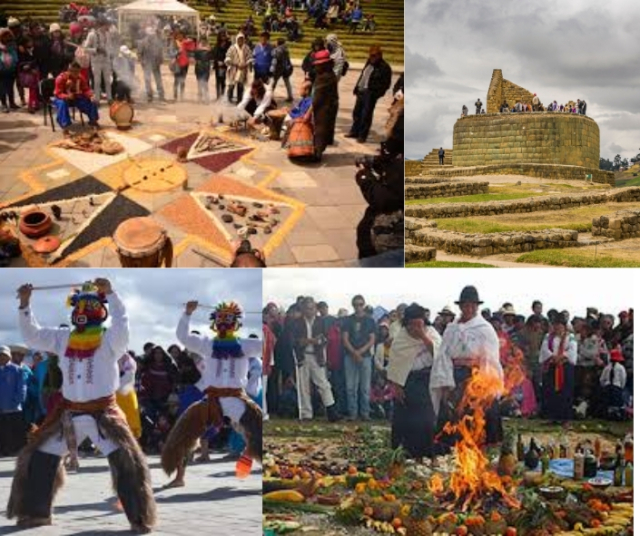Inti Raymi, an ancestral festival of Inca origin, is a day of great importance for many indigenous peoples of South America, including Ecuador. This celebration, which marks the winter solstice in the southern hemisphere, is a time of renewal and reverence toward the sun, a fundamental deity in Andean traditions. In this extensive article, we will explore in detail the meaning, traditions and cultural importance of Inti Raymi in Ecuador, as well as its relevance in the historical and contemporary context of the country.
The Inti Raymi:
Inti Raymi, which means "Festival of the Sun" in Quechua, is an ancient ceremony celebrated by the indigenous people of the Andes to pay tribute to the sun and give thanks for the fertility of the land, abundant harvest and renewal of life. This holiday has its roots in the religious traditions of the Incas, who worshiped the sun as a supreme deity and considered its light and heat to be vital to the prosperity and well-being of their communities.
In Ecuador, Inti Raymi is celebrated on June 21 by several indigenous groups, including the Quichuas, the Puruhaes and the Saraguros, among others. Although the holiday may vary in different regions of the country, it shares common elements such as ceremonial rituals, traditional dances, music, food and drink, all intended to honor the sun and promote harmony and connection with nature.
Cultural and Spiritual Meaning:
The Inti Raymi has a deep cultural and spiritual meaning for the indigenous peoples of Ecuador, as it represents a connection with their ancestors, their land and their ancestral traditions. This holiday is seen as an opportunity to renew the sacred bond between humanity and nature, as well as to honor the wisdom and values passed down by past generations.
For many indigenous Ecuadorians, Inti Raymi is more than just a celebration; It is a time of reflection, gratitude and spiritual renewal. During the festival, ceremonial rituals are performed to thank the sun for its light and warmth, as well as to ask for blessings for the coming harvest, health and well-being of the community.
Traditions and Practices:
Inti Raymi celebrations in Ecuador can vary by region and community, but typically include a number of traditional rituals and practices. Among these are:
Gratitude Ceremonies:
During Inti Raymi, ceremonial ceremonies are held in which offerings are offered to the sun, such as food, flowers, coca leaves, and chicha, a fermented drink made from corn. These offerings are considered a sign of gratitude and respect towards the sun and the earth for their generosity and benevolence.
Dances and Music:
Dance and music are an integral part of the Inti Raymi celebrations in Ecuador. Participants dance to traditional music, wearing colorful clothing and elaborate masks representing animals, gods, and nature spirits. These dances are a form of artistic and spiritual expression that connects the community with its cultural roots and indigenous identity.
Purification Ceremonies:
Some communities perform purification ceremonies during Inti Raymi, in which cleansing and healing rituals are practiced to purify the body, mind and spirit. These ceremonies often involve the use of medicinal herbs, ritual baths, and prayers to invoke the protection and support of nature spirits.
Community Meetings:
Inti Raymi is also an occasion for indigenous communities to meet and strengthen their social ties, sharing food, stories, songs and dances. These community meetings foster a sense of belonging and solidarity among community members, thus strengthening their cohesion and resilience.
Historical and Contemporary Importance:
The Inti Raymi has great historical and contemporary importance in Ecuador, as it represents a living connection with the ancestral traditions of indigenous peoples and their resistance against colonization and cultural oppression. This festival is a manifestation of cultural resistance and the fight for the preservation of indigenous identity in a context of change and modernization.
Today, Inti Raymi continues to be celebrated by many indigenous Ecuadorians as a way to affirm their cultural identity and reaffirm their connection to the land, nature, and their ancestral roots. Although the holiday has evolved over time and adapted to changing conditions, it remains an important part of Ecuador's cultural and spiritual heritage.
Inti Raymi is an ancestral festival of great importance to the indigenous peoples of Ecuador, marking the winter solstice and celebrating the renewal of life and connection with nature. This holiday is an opportunity to honor the sun and give thanks for its blessings, as well as to strengthen community ties and reaffirm the cultural and spiritual identity of indigenous Ecuadorians. Through its rituals, dances and ceremonies, Inti Raymi reminds us of the importance of preserving and valuing the ancestral traditions that have shaped our history and our identity as a nation.
